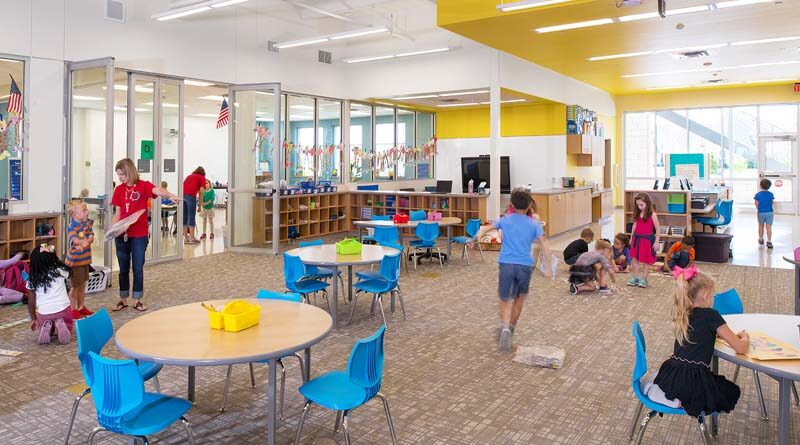Core Considerations for Early Childhood Classroom Design
By Michael Lovaglio
Driven by new paradigms in curriculum delivery and promising new research on what helps young learners excel, the early childhood classroom environment is changing.
This change is rapid and far from uniform. There is no single prototype or solution that fits every classroom. Each school and district have a unique set of students, teachers, and parents with their own goals and objectives. We must involve all stakeholders in discovering what best fits their needs as layout and instructional space is developed — mixing ideas and strategies for engagement.
Broadly speaking, we can pinpoint a few trends emerging that support exceptional early child learning. Spatial flexibility is key in a time of dynamic pedagogy, while choice and discovery are important for children’s social, intellectual, and emotional growth. The availability and appropriate use of technology must be woven into this new environment. But with screen time a concern, we must look for designs that inspire rather than overstimulate.
Personalization
The ideal classroom encourages student choice of “where and how to learn.” This personalization of spatial identity supports student creativity, innovation, and socialization. Early evidence collected by RAND Corporation, researchers for the Bill & Melinda Gates Foundation, found “that personalized learning (PL) can improve achievement for all students, regardless of their starting level of achievement, and students who are able to personalize their space perform better.”
Flexible spaces and technology play important roles in supporting this personalization. A 2016 report, commissioned by the Ministry of Education in New Zealand, researched the connection of overall facility quality and design and its impact on student outcomes. They found that “flexible learning environments imply that the school adapts the use of resources such as staff, space, and time to best support personalization.”
Flexible Spaces
Schools have different pedagogical methods and instructional styles which require flexibility in furniture arrangement, equipment portability, classroom size, and classroom layout. In lieu of the traditional “rows of desks” and “sit and get” instruction, students thrive on a variety of learning activities. By not limiting a classroom to the traditional four walls, a larger and more flexible classroom environment can offer many more opportunities for instruction, spaces for groups of different sizes, and areas for independent or collaborative work.
The increased transparency of a larger instructional space fosters more collaboration between teachers, a shared responsibility for all students, and encourages higher performance. At Richard J. Lee Elementary School in Coppell, Texas, even the Kinder areas take advantage of shared spaces in and out of the classroom that are designed to serve a variety of learners, learning styles, and activities.
In addition to classroom layout qualities, the New Zealand study identified four core technical features within flexible learning spaces and their direct impact on student outcomes. They found that higher quality buildings and facilities are linked to better student achievement and engagement outcomes with students feeling happier and feel more valued.
- Acoustics: Quality acoustics temper distracting excess noise and lead to calmer environments where students can better interact with each other and the teaching staff.
- Lighting: Natural light is best, but windows must be thoughtfully designed to limit visual distractions, prevent impairing glare during instruction, and minimize solar heat gain.
- Ventilation: Better indoor air quality (IAQ) and minimizing volatile organic compounds (VOCs) has shown to reduce health-related issues, such as asthma or allergic reactions, which directly affects absenteeism or distraction in class.
- Heating and cooling: Teachers need the ability to control temperatures of the classroom to complement various activities and the overall comfort of the room.
Overstimulation
The visual environment of the classroom was studied by researchers at Carnegie Mellon University to understand children’s ability to maintain a focused attention during instruction. They found that “the students in a highly decorated classroom spent more time off-task (38.6% time spent off-task) than in a more-sparse classroom (28.4% time spent off-task).” An over-designed space and overstimulating environment can flood a child’s day with too many experiences, sensations, and activities –negatively impacting student achievement.
Technology distraction in early child classrooms is heavily debated by educators and parents today. When it comes to screen time, experts recommend a limit of one hour a day of high-quality programming for children two to five years of age. The Mayo Clinic says “unstructured playtime is more valuable for a young child’s developing brain than is electronic media.” But with the next generation of parents, likely to be more digitally savvy, we will see a shift toward more screen time. We need to be cautious about how we enrich instructional spaces and carefully consider which additions, both technological and environmental, might be too distracting to early learners.
Technology
It was just 10 years ago when the first tablet was introduced. Fast forward to current day and technology has become a staple in most learning environments. But how much technology is appropriate for early learners?
When our team was designing Prestwick STEM Academy in The Colony, Texas, placement of technology was an important and collaborative discussion. Solutions varied by age group. In the kindergarten areas, TVs and computers were not the focus within the classroom environment. Finding the correct balance of technology was key. It did not want to be too overwhelming and dominating within the space but the technology still needed to be readily accessible to students.
How we look at technology in classrooms will evolve. Over the next decade, early child and pre-k classrooms will be occupied by children whose parents are “digital natives.” These future parents, born after 1997, will have new expectations for technology integration in the classroom. A greater variety of technological mediums, some yet to be invented, could become more essential for enhanced learning and increased engagement for tomorrow’s students.
Michael Lovaglio, AIA, RID, NCARB, is a principal with Stantec.

